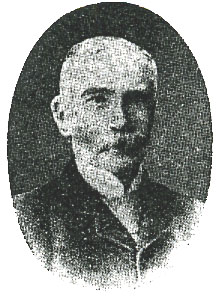- William Gowland
Infobox Person
name = William Gowland
caption = William Gowland
birth_date = 1842
birth_place =Sunderland ,England
death_date =9 June 1922
death_place =London ,England
other_names =
known_for = Foreign advisor to MeijiJapan
occupation = metallurgist, amateur archaeologist, foreign advisor to Japan
nationality =England William Gowland (1842 –
9 June 1922 ) was a English miningengineer most famous for hisarchaeological work atStonehenge and inJapan . He is known in Japan as the “Father of Japanese Archaeology”.Biography
Gowland was born in
Sunderland ,Tyne and Wear in northern England. He attended theRoyal College of Chemistry andRoyal School of Mines atSouth Kensington specializing inmetallurgy , and worked as a chemist and metallurgist at the Broughton Copper Company from 1870-1872. However, in 1872, at the age of 30, he was recruited by theMeiji government of theEmpire of Japan as a foreign engineering advisor at the "Osaka Zōheikyoku", the forerunner of theJapan Mint .In Japan (1872-88)
Gowland began work in
Osaka on8 October 1872 on the three year contract typical of many of the foreigners employed to aid the modernization of Japan. His contract was extended repeatedly, and he stayed for a total of 16 years, during which time he introduced techniques for the scientific analysis of metals, the production ofbronze andcopper alloy s forcoinage , and modern technologies such as thereverberatory furnace for improving the efficiency ofrefining copper ore s. His expertise extended to areas outside of the Japan Mint, and he also served as a consultant to theImperial Japanese Army , helping establish the Osaka Arsenal for production ofartillery . He was awarded theOrder of the Rising Sun (4th class) by the Japanese government in 1883.During his spare time in Japan, Gowland enjoyed
mountaineering , making the first recorded ascent on several peaks of theJapanese Alps , a name which Gowland coined and which was published in 1888 byBasil Hall Chamberlain in his "Japan Guide". The name was later popularized by English missionaryWalter Weston . Gowland also claimed to have been the first foreigner known to have climbedMount Yari in 1874. [ [http://search.japantimes.co.jp/cgi-bin/fl20020421a1.html] Japan Times April 21 2002]However, Gowland is best known in Japan as an amateur archaelogist, conducting the first truly accurate scientific surveys of a number of
Kofun period (3rd-7th centuries AD) burial mounds ( "kofun " ), including a number of imperial mausolea. He excavatedburial mounds inSaga prefecture andMiyazaki prefecture onKyushu as well as inFukushima Prefecture north ofTokyo , in addition to numerous sites in theKinki region .On Gowlands departure from Japan, he was awarded the Order of the Rising Sun, 3rd class and a 3000
yen bonus from then-Finance MinisterMatsukata Masayoshi . Once back in his native England, he published numerous works on his researches in Japan, and was elected a Fellow of theRoyal Society . Many of the artifacts he brought back to England are now at theBritish Museum . Gowland was also an avid collector of "Nihonga " style Japanese paintings.In England
On New Year's Eve 1900, Stone 22 of the
Sarsen Circle fell over, taking with it alintel . Following public pressure and a letter toThe Times byWilliam Flinders Petrie , The owner, Edmund Antrobus, agreed to remedial engineering work under archaeological supervision so that records could be made of the below ground archaeology.Antrobus appointed Gowland to manage the job, who despite having no formal archaeological training, produced some of the finest, most detailed excavation records ever made at the monument. The only area he opened was that around the then precariously leaning Stone 56 (the western stone of the Great Trilithon), an area measuring around 17ft by 13ft, and the difficulty was compounded in that only small areas were dug at each time to allow
concrete to be poured and set.Despite these difficulties, he established that antler picks had been used to dig the stone holes and that the stones themselves had been worked to shape on site. His work identified the 'Stonehenge layer', a thin strata of
bluestone chips that sealed many of the non-megalithic features at the site and proved that they predated the standing stones.Gowland died in
London on9 June 1922 at the age of 80, and was buried atMarylebon Cemetery .elected works
* "The Dolmens and other Antiquities of Korea", 1895
* "The Art of Casting Bronze in Japan", 1896
* "The Dolmens and Burial Mounds in Japan", 1897
* "The Dolmens of Japan and their Builders", 1900
* "The Burial Mounds and Dolmens of the Early Emperors of Japan", 1907
* "The Art of Working Metals in Japan", 1910
* "Metals in Antiquity", 1912
* "The Metallurgy of Non-ferrous Metals", 1914
* "Metal and Metal-Working in Old Japan", 1915
* "Silver in Roman and Earlier Times", 1920Notes
References
*Chippendale, C "Stonehenge Complete" (Thames and Hudson, London, 2004)
* "William Gowland: The Father of Japanese Archaeology", edited by Victor Harris and Kazuo Goto, British Museum Press 2004, ISBN 0-7141-2420-6ee also
*
Anglo-Japanese relations External links
* [http://www3.imperial.ac.uk/materials/aboutus/history/gowland Imperial College London]
Wikimedia Foundation. 2010.
